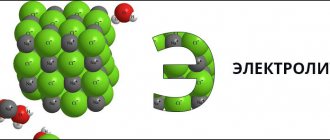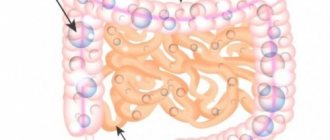General information
The human body is designed in such a way that as we age, all organs gradually wear out.
And in order for each organ to serve “without breakdowns” for as long as possible, it is important to ensure high-quality disease prevention. If we are talking about the most important organ - the heart, then prevention methods consist of giving up alcohol consumption and smoking, losing body weight, and normalizing lipid metabolism. However, in addition to the points described, the use of potassium and magnesium supplements will help prevent cardiovascular diseases and their complications. Why such medications are needed for the body, in what cases potassium and magnesium preparations are used, and why you need to consume foods containing magnesium and potassium will be discussed in the article below.
Potassium deficiency and heart rhythm disturbances
Potassium is required for the proper functioning of a wide range of intracellular enzymes. The trace element helps maintain normal acid-base and osmotic homeostasis, participates in the synthesis of glycogen, protein, central nervous system mediators, etc. With potassium deficiency, the cardiovascular system most often suffers. Against the background of microelement deficiency, autonomic cardioneuropathy may develop. The pathology is accompanied by complex rhythm disturbances, including atrial fibrillation. In some cases, it leads to death - sudden cardiac death. A lack of potassium can also aggravate the course of hypertension and increase the risk of developing a cerebral stroke. With a deficiency of this microelement, a pathological U wave, a smoothed T scar, and multifocal extrasystoles are usually recorded on the patient’s electrocardiogram.
What are the benefits of magnesium and potassium?
Potassium
Taking potassium supplements is very important for the prevention of heart and vascular diseases. After all, potassium in the body promotes the functioning of the conduction system of the heart and ensures the regulation of blood pressure . It is important to take medications containing potassium not only for the heart. This mineral determines the transmission of excitation from nerve cells to muscles and is responsible for maintaining water and electrolyte balance. By activating enzymes , potassium participates in the regulation of protein and carbohydrate metabolism. It also takes part in the synthesis of proteins and the conversion of glucose into glycogen .
Potassium preparations in tablets help to activate urine flow.
Potassium is contained in tablets, the price of which is relatively low. However, some complex drugs have a higher cost.
You can replenish your reserves of this microelement by consuming foods high in it. A large amount of potassium is found in dried fruits (raisins and dried apricots), leafy greens, legumes, watermelons, melons, kiwi, etc. Slightly less of this trace element is found in potatoes, milk, and beef.
The adult body needs from 2 to 5 g of potassium per day from food (this depends on physical activity). However, it is important to know that approximately 90% of potassium is absorbed from food. This is provided that the absorption process occurs normally and there is no diarrhea or vomiting.
Magnesium
Magnesium in the body promotes the breakdown of glucose. It is involved in various enzymatic reactions that help increase cell stability and renewal. Due to the synthesis of B vitamins, magnesium improves the process of neuromuscular transmission. Therefore, magnesium preparations are indicated for various diseases. In particular, preparations with magnesium are effective for leg cramps.
If you take medications containing potassium, magnesium and calcium, vascular tone improves. Also, magnesium, when interacting with potassium, takes part in muscle contraction.
The use of magnesium is also advisable from the point of view that it activates the absorption of potassium and regulates the content of this trace element in the blood. The optimal ratio of potassium and magnesium in food is 2 to 1. This allows you to maintain the density of bone tissue and protect teeth from destruction.
Preparations containing magnesium are also taken “for the heart,” since this microelement stabilizes cell membranes, allowing potassium and chlorine ions to penetrate through them. This allows you to lower blood pressure and stabilize the heart rhythm.
The price of such drugs may vary. But it is not always necessary to take magnesium-containing medications. After all, a large amount of this microelement is found in food products - legumes, cereals, cabbage, seafood, fish, nuts, etc.
Magnesium is easily absorbed from consumed dairy products, although they contain relatively little of it. A person should receive 400 mg of this microelement per day.
Magnesium: heart, muscles and nerves are fine
Magnesium is involved in the work of about 300 enzymes in our body. Thus, magnesium takes part in many processes occurring in the body - this includes energy metabolism, the synthesis of proteins, fats and nucleic acids, and participation in various signaling cascades. Magnesium helps relax smooth muscles, acting as a counterbalance to calcium. At the same time, a fifth of all magnesium in our body is located in the heart, and this alone indicates how important this macroelement is for the functioning of our main motor. Magnesium also plays an important role in protecting the nervous system from destructive stress (Yarosh A.K., 2010). The daily requirement for magnesium for men is 350 mg, for women - 300 mg, and for young people, pregnant and breastfeeding, this figure can increase by another 150 mg. However, the total amount of magnesium in the human body is only about 24 g, most of which is found in muscle and bone tissue. It should be noted that the need for magnesium increases significantly during physical activity, stress, in hot climates, when visiting a bathhouse, alcohol abuse, unbalanced restrictive diets and chronic fatigue syndrome (Nedogoda S.V., 2009).
What foods do we get magnesium from? First, magnesium is found in regular drinking water, but its concentration can vary significantly. In some regions with “soft” water, its level in the water is much lower. In addition, some substances, for example those contained in tea, can negatively affect the absorption of magnesium in the digestive tract. Nuts, dark chocolate and legumes are rich in magnesium, but a significant increase in the consumption of these products can lead to the appearance of a couple of extra pounds due to their high calorie content. Other less nutritious foods include spinach, broccoli and rhubarb, but they do not meet the body's daily requirement for magnesium. In addition, only 30% of the magnesium we get from food is absorbed in the digestive tract. The absorption of magnesium is negatively affected by excess consumption of calcium, sodium, protein or fat from food, which significantly reduces the intake of magnesium in the body due to the formation of its non-absorbable complexes. Thus, the most common cause of magnesium deficiency is precisely insufficient dietary intake. Magnesium deficiency can also be caused by taking certain drugs, for example, diuretics, caffeine, some antibiotics and estrogen-containing drugs (Postnikova S.L. et al., 2007). As a result, magnesium deficiency can occur in 40% of the population (S.V. Nedogoda, 2009).
What does excess magnesium and potassium lead to?
It is very important that a person takes magnesium- and potassium-containing drugs strictly according to indications and in the dosage prescribed by the doctor. You cannot choose a medicine by reading information about it or listening to the recommendations of a pharmacist. The most important thing is to never listen to harmful advice that large doses of such drugs can “strengthen the heart” and “improve blood vessels.”
Excess potassium
The maximum dose of potassium per day is 6 g. If a person consumes 14 g, his heart may stop. An initial excess of this mineral is possible if a person has:
- type 2 diabetes mellitus
- chronic renal failure ;
- extensive injuries with crushing tissue;
- consequences of exposure to radiation or the use of cytostatics.
If you consume high doses of this microelement over a long period of time, the consequence may be:
- heart rhythm disturbances;
- muscle weakness;
- anxiety, irritability;
- nausea, intestinal colic, vomiting, diarrhea ;
- diabetes;
- frequent urination.
Excess magnesium
The maximum daily dose of magnesium is 800 mg per day. An overdose is not fatal, but if it occurs, the following effects may occur:
- stones in the kidneys;
- chronic fatigue;
- psoriasis;
- hyperthyroidism.
Excessive magnesium retention is observed if a person suffers from chronic renal failure.
Potassium and magnesium preparations for the heart and blood vessels
In modern pharmacology, potassium and magnesium tablets are offered in different versions, and their prices also vary. Potassium and magnesium preparations in tablets of varying prices are described below.
Panangin
This is an inexpensive remedy with potassium and magnesium, which many take as a medicine “for the heart.” After all, very often magnesium and potassium for the heart are taken for any problems with this organ, believing that this will help “support” the heart.
However, drugs with these components are not as harmless as many people think.
The main indication for the use of Panangin is the replacement of potassium losses when using diuretic drugs for the treatment of chronic heart failure or diuretics that do not conserve potassium. It is advisable to take Panangin when treating with Torasemide , Furosemide , Diacarb , etc.
If the patient is prescribed to take potassium-sparing diuretics, such as Amiloride , Triamterene , Veroshpiron , Triampur , etc., there is no need to use an additional product with this microelement. There is no need to take potassium-containing medications when taking Indapamide and Hypothiazide .
Panangin normalizes heart rhythm during ventricular arrhythmias . In the treatment of atrial fibrillation and paroxysmal tachycardia , it is usually used as an adjuvant. Along with antiarrhythmic drugs, Panangin is prescribed for atrial rhythm disturbances.
For the purpose of prevention, this drug is prescribed to elderly people who often have repeated attacks of paroxysmal tachycardia, extrasystole, and at the same time the level of potassium in the blood is very low. It is also advisable to take this medicine for unstable arterial hypertension or frequent attacks of angina .
Panangin reduces the severity of side effects when using cardiac glycosides and improves the tolerability of such drugs.
Panangin is contraindicated: for myasthenia gravis , acidosis , cardiogenic shock with low blood pressure, atrioventricular blockade, dehydration, hemolysis , metabolic disorders of magnesium and potassium. Nursing mothers and pregnant women should take it with caution.
When taking Panangin simultaneously with ACE inhibitors, beta-blockers, NSAIDs, cyclosporines, the risk of potassium overdose increases.
Cost – from 300 rubles. per pack 60 pcs.
Asparkam
The composition is similar to Panangin. Asparkam tablets have similar contraindications and side effects. The cost of the drug is from 50 rubles. for 20 pcs.
Also analogues of the drug Panangin are Pamaton , Asparkam , Potassium-magnesium aspartate - tablets and solution for infusion. If the body needs potassium or magnesium, a dropper is placed with this drug.
Orocamage
These are capsules of potassium and magnesium orotate. Orocamag is used as part of complex treatment of supraventricular extrasystole and unstable angina . Contraindications and side effects are the same as for Panangin. Orocamag is not prescribed to expectant mothers or nursing mothers.
Increased need for potassium
The need for potassium increases when it is lost in significant quantities by the body. For example, this is observed during intense sports, increased sweating, and kidney diseases, which are accompanied by impaired kidney function.
Potassium loss occurs when taking diuretics (they are used mainly for kidney disease and chronic heart failure). Sometimes drugs with a diuretic effect are also used by healthy people for the purpose of weight loss. Accordingly, they also need an increased supply of potassium.
People with an increased need for the element often need to use potassium in their medications.
Magnesium preparations
Magnerot
These 500 mg tablets contain magnesium orotate dihydrate . Magnerot is used for a deficiency of magnesium in the body, for arrhythmia associated with such a deficiency, as well as in the treatment of atherosclerosis , endarteritis , chronic heart failure, muscle spasms, myocardial infarction , and metabolic disorders of fats.
Negative effects may include allergic reactions, nausea, diarrhea , and appetite disturbances. Expectant mothers and women during lactation can use the product if they have a normal level of magnesium in their blood.
Contraindicated for use in people with urolithiasis, liver cirrhosis , renal failure, lactase deficiency, and impaired glucose absorption.
Cost – from 330 rubles. for 20 pcs.
Doppelhertz Active
Dietary supplement that combines two microelements. Indications for the use of Doppelhertz Active magnesium + potassium are the same as for the use of Magnerot.
Cost – from 360 rubles. for 30 tab.
Medicines for seizures
Potassium and magnesium preparations are used for seizures . The manifestation of convulsions, tingling sensations, and “goosebumps” appear as a consequence of impaired neuromuscular transmission. Sometimes such manifestations are the consequences of a lack of magnesium in the body. A person becomes worse due to a lack of B vitamins , since this microelement is directly involved in their synthesis.
The development of muscle cramps occurs in the following cases:
- during dehydration;
- during treatment with laxatives or diuretics;
- with electrolyte disturbances due to diarrhea and vomiting;
- due to frequent bowel cleansing with an enema;
- during fasting.
Most often, cramps bother older people at night. During this period, involuntary twitching and numbness of one or both legs suddenly begin. This unpleasant phenomenon not only disrupts sleep, but also causes very unpleasant sensations. Most often this happens due to the following reasons:
- poisoning with aluminum, lead, cadmium, manganese, nickel, cobalt, beryllium;
- alcohol abuse;
- diabetes;
- resection of the small intestine, malabsorption in the small intestine;
- taking antitumor drugs, Gentamicin .
It is possible that spasms may occur not only in the limbs, but also in different muscle groups. Such manifestations are not uncommon during pregnancy, as well as in children - during the period when the child is actively growing.
Proper treatment, which includes medications with magnesium and vitamin B6 .
Magne B6
This is magnesium in tablets and in the form of a solution for oral use. The product contains magnesium lactate dihydrate (corresponding to 48 mg of divalent magnesium) and pyridoxine hydrochloride (B6).
Magne B6 is used for muscle spasms, a lack of this microelement, heart rhythm disturbances, spasms in the gastrointestinal tract, high excitability and irritability, and sleep problems.
How to take magnesium with B6 is indicated in the instructions. It is prescribed in courses, each of which lasts at least 4 weeks. You need to take 6-8 tablets per day in 3-4 doses. Both the solution and the tablets should be taken with food, washed down with liquid.
People with renal failure , fructose intolerance, and impaired absorption of sucrose and glucose should not be treated with Magne B6 Not prescribed to children under 6 years of age. The active components penetrate the placenta and are detected in milk, so it is not recommended for pregnant and lactating women to take the product.
You cannot combine its use with treatment with Levodopa .
Possible negative effects: vomiting, nausea, flatulence , diarrhea .
Poisoning with the drug is possible only if the glomerular filtration rate of the kidneys decreases significantly. The consequences of poisoning are: a significant drop in blood pressure, depression, vomiting, diarrhea, respiratory depression, and irregular heartbeat.
Magnesium B6 costs in tablets depends on the manufacturer and the drug. Price Magnesium B6 in tablets – from 580 rub. for 30 pcs., in ampoules - from 530 rubles. for 10 pcs. There are also a number of analogues of the drug Magne B6. These medications are Magnesium B6 forte , Magne Express Sachet , Systematic Magnesium+B6 , Magnelis B6 .
Magnistad
These are vitamins with magnesium, which include magnesium lactate dihydrate (470 mg) and pyridoxine hydrochloride (5 mg). These magnesium-containing vitamins are maximally absorbed due to the presence of a coating that dissolves in the intestines.
All negative effects, indications and contraindications are similar to the same points in the instructions for Magna B6.
The cost of Magnistad is from 325 rubles. for 50 pcs.
Vitamins with potassium and magnesium
In every pharmacy on the shelves you can see numerous names of vitamins with magnesium and potassium. Vitamins, which also contain microelements, are widely produced and used for various conditions and diseases.
Popular products are Makrovit , Duovit , Vitrum , Teravit , Complivit , etc. They contain not only potassium, magnesium and potassium in the tablets, but also other microelements and vitamins necessary for the human body.
Potassium + Magnesium = Inseparable couple
The levels of these elements in our body are connected - a deficiency of one negatively affects the level of the other and vice versa. Magnesium prevents the loss of potassium, promoting its fixation in the cell and normalization of its intracellular content (Yarosh A.K., 2010). Magnesium owes these properties to the fact that it participates in the work of the enzyme that “pumps” potassium into the cell. A study of cellular models confirmed the critical role of magnesium in maintaining intracellular potassium levels (Kotova O.V., Ryabokon I.V., 2012). It is worth noting that when replenishing magnesium deficiency, potassium losses are reduced. At the same time, the magnesium content depends on the potassium concentration (Postnikova S.L. et al., 2007). However, most patients with potassium deficiency may also have magnesium deficiency. This makes it advisable to use drugs containing both magnesium and potassium.
Other drugs
Magnesia (Magnesium sulfate)
A medicine with an antihypertensive effect that effectively reduces the swelling of the vascular walls, which leads to a decrease in blood pressure. For a long time, magnesia was used as a medicine to relieve hypertensive crises. It was also used for this purpose for expectant mothers.
Currently, magnesia is primarily used as a medicine that effectively reduces intracranial pressure . To do this, it is administered intramuscularly.
Magnesia powder is a laxative that stimulates the passage of bile . As a result, bile acids have a laxative effect. At one time, many people practiced so-called liver tubages . This procedure consisted of the following: it was necessary to take magnesium sulfate and lie on the right side, placing a heating pad under it to increase the passage of bile. Currently, such actions are no longer practiced, since the effect of ursodeoxycholic acid in this case is more pronounced.
Magnesia is used intravenously during pregnancy to reduce edema, as well as to reduce the tone of the uterus.
In addition, drugs with magnesium and potassium are included in polarizing mixtures, which modern anesthesiologists do not consider seriously.
Potassium: the heart's fiery engine
Potassium is the main intracellular cation, maintaining a certain ratio of concentrations in cells and extracellular space is extremely important for the normal functioning of nervous and muscle tissue. Maintaining the required ratio is achieved through the work of an enzyme that transports potassium ions into the cell and sodium ions out of it. And for the normal functioning of this enzyme, magnesium is necessary. Interestingly, the loss of potassium from the extracellular space is quickly compensated for by its supply from the cells, due to which the concentration of this ion in the extracellular space can remain within normal limits for quite a long time. As a result, critical potassium deficiency, fraught with cardiovascular and neuromuscular disorders, often goes unnoticed in standard studies (Lyashenko E.A., 2012). Potassium deficiency mainly develops due to its insufficient intake from food, intense fluid loss (diarrhea, increased sweating, taking diuretics or laxatives), and also, very importantly, magnesium deficiency. In addition, patients with diabetes are at risk for developing potassium deficiency (Lyashenko E.A., 2012).
How many microelements are contained in foods?
To eliminate the deficiency of these elements, you should include foods rich in potassium and magnesium in your diet. For your heart, it is recommended to eat some foods containing potassium and magnesium.
You can find out which foods contain magnesium and potassium from the table below. The list of foods containing a lot of these microelements is quite wide. And everyone can choose the optimal source of these elements for themselves. But provided that the nutrition is complete and absorption occurs normally, a deficiency of these elements should not develop.
The table of foods containing potassium and magnesium informs you which foods contain the maximum amount. Indicators are given in mg per 100 g of product. So, what contains the maximum of these elements?
| Product | Potassium amount | Amount of magnesium |
| watermelon | 175 | 25 |
| avocado | 440 | 125 |
| apricots | 340 | 20 |
| oranges | 160 | 13 |
| bananas | 390 | 40 |
| grape | 215 | 18 |
| cherry | 290 | 27 |
| peach | 150 | 15 |
| apple | 108 | 9 |
| nuts | 750 | 160 |
| beans | 1020 | 130 |
| broccoli, cauliflower | 360 | 18 |
| potato | 470 | 24 |
| carrot | 310 | 38 |
| milk | 140 | 12 |
| cheese | 100 | 46 |
| eggs | 140 | 12 |
| herring | 90 | 160 |
| meat – pork, beef | 100 | 28 |
| buckwheat | 380 | 78 |
| wheat bran | 1150 | 570 |
| oatmeal | 350 | 133 |
| rice | 100 | 30 |
| raisin | 1020 | 60 |
| dried apricots | 1876 | 50 |
| coffee | 1750 | 1 |
| tea | 2367 | — |
| cocoa | 1660 | 170 |
conclusions
Preparations containing these two microelements are of great auxiliary value in the treatment of various diseases. But, above all, they are important as a means of replacement treatment for a lack of magnesium and potassium in the body.
It is a mistake to believe that such drugs are drugs for the heart, and these drugs cannot be taken uncontrolled. Any list of heart pills should be prescribed by a doctor after a comprehensive study, and heart vitamins in tablets are an auxiliary product that is also taken as prescribed by a doctor as part of a comprehensive treatment.






